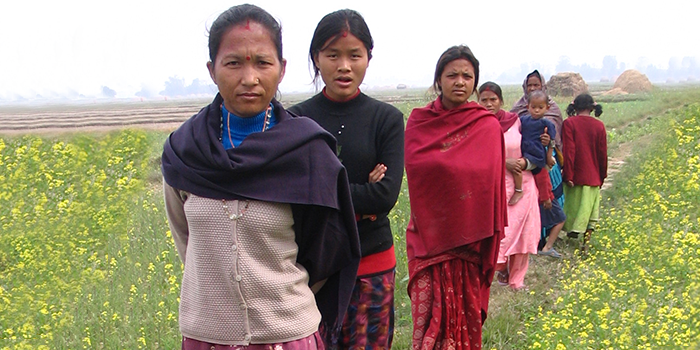2020 represents a momentous year for women’s rights. A time to look back and to look ahead.
This year marks the 25th anniversary of the historic Beijing Conference on Women, which brought together representatives of governments, UN agencies, activists, and organizations from around the world to produce a plan for the advancement of women and the achievement of gender equality. It was also where the now-famous line “women’s rights are human rights” was taken up as a rallying cry by advocates and activistsThe Beijing Declaration and Platform for Action would go on to serve as a blueprint for advancing women’s rights.
Since then, we have seen important moments in women’s rights, from UN-led initiatives, such as the 2000 Security Council Resolution 1325 on Women, Peace, and Security, to grassroots and women-led initiatives like the original “Me Too” movement founded by Tarana Burke in 2006 to support survivors of sexual harassment and assault. The more recent #MeToo mobilization, which resulted as a response to widespread sexual abuse allegations against Harvey Weinstein, and Time’s Up have brought forth the truth about how gender inequality affects women and girls in film and sports, in their homes and on the streets, in business and politics.
A groundswell of support—also led by women for women—saw the inaugural Women’s March in January 2017, when more than 11 million people were galvanized to take to the streets in 800 cities around the world to protest misogyny, patriarchy, and inequality.
And now we are watching governments establish feminist foreign assistance policies that aim to change the political, economic, and social structures that perpetuate enduring inequalities. Sweden became the first country to publicly adopt a feminist foreign policy, putting the promotion of gender equality and women’s rights at the center of its diplomatic agenda. This policy focuses on women’s rights, representation, and resources. Canada and Mexico have also adopted feminist foreign policies, and France and Luxembourg have announced their intention to do so.
From Beijing to #MeToo to women’s marches and government policy changes, women around the world—and the men who support them—are challenging the oppression of women and demanding equity and justice.
I have been working on gender equality for more than 20 years and in that time I have witnessed, benefited from, and been a part of a lot of inspiring change. I recently joined the Women’s Refugee Commission because I have seen that the organization’s feminist research and advocacy approach to creating change though partnering with displaced communities, women’s groups, organizations of people with disabilities, governments, and humanitarians can create the change we need to achieve gender equality.
Despite progress, however, much is left to accomplish.
Systems are failing refugee women and girls
There is widespread recognition that the systems we have in place to provide life-saving services and shelter to, and uphold the rights of, communities fleeing war, persecution, the climate crisis, and natural disasters are failing women and girls, especially those who are most marginalized, such as people with disabilities and adolescent girls. They are missing women’s and girls’ critical leadership and contributions, and are denying them the fulfillment of their human rights. While there is much agreement about policies and principles, the task of actually achieving the kind of transformative change that will create a gender-equitable world remains to be fulfilled.
Five steps to a more equitable world
We know that if we don’t change the political, economic, and social systems that perpetuate gender inequalities, they will continue. In other words, if our policies, programming, and funding do not explicitly combat gender inequalities, then we are, however unwittingly, upholding them. Here are some thoughts for the work that remains to be done to create the equitable world we envision:
- Women must lead: Women’s organizations and movements are on the front lines of responding to the causes and consequences of displacement—the climate crisis, economic policies that put profit over people, and conflict. They must be at the center of creating and implementing strategies aimed at women’s and girls’ well-being and the fulfillment of their human rights.
- Shift power and resources: Money and decision-making power must be shifted to women-led organizations and feminist movements, both those in and of the communities that are displaced, and those in host countries. Funding must support transformative change—this is a long-term task and will not be achieved with short-term project-based funding.
- Solidarity: Displaced and host communities are both affected by displacement. We must invest in creating common cause and solidarity. We must ask who exactly is being left out, and how can we ensure their visibility and meaningful engagement. Women’s movements—local, national, and international—are central to this work.
- Alternative economic systems: An economic system that puts profits over people is a significant human cause of the climate crisis and forced migration. We must invest in economic systems that center on the creation of equity, sustainability, and well-being.
- Accountability: To make well-meaning gender equality policies a reality, we must create accountability mechanisms so that women’s organizations and movements can hold accountable the systems that should serve them.
Today, as we celebrate Women’s History Month and mark International Women’s Day (March 8), we join with our colleagues and allies around the world to celebrate and to galvanize efforts to make sure that “women’s rights are human rights” for all women, everywhere.
Follow the Women’s Refugee Commission on Instagram to see our Women’s History Month posts on remarkable women who are making a difference.


